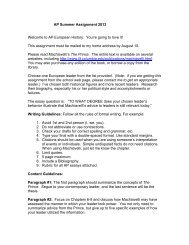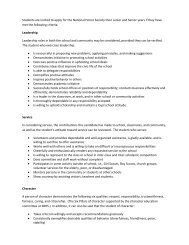Studying Rudin's Principles of Mathematical Analysis Through ...
Studying Rudin's Principles of Mathematical Analysis Through ...
Studying Rudin's Principles of Mathematical Analysis Through ...
Create successful ePaper yourself
Turn your PDF publications into a flip-book with our unique Google optimized e-Paper software.
1.9. CONCEPTS FROM THE 2ED 11<br />
1.8.5 Step 5<br />
Having proved that the addition defined in Step 4 satisfies Axioms (A) <strong>of</strong> Definition 1.12, it follows that<br />
Proposition 1.14 is valid in R. Prove one <strong>of</strong> the requirements <strong>of</strong> Definition 1.17: If α, β, γ in R and<br />
β < γ then, α + β < α + γ and that α > 0* if and only if −α < 0*.<br />
1.8.6 Step 6<br />
Multiplication is a little more bothersome than addition in the present context, since products <strong>of</strong> negative<br />
rationals are positive. For this reason we confine ourselves first to R + , the set <strong>of</strong> all α ∈ R with α > 0*.<br />
If α, β ∈ R + , define αβ to be the set <strong>of</strong> all p such that p ≤ rs for some choice <strong>of</strong> r ∈ α, s ∈ β, r ><br />
0, s > 0. Define 1* to be the set <strong>of</strong> all q < 1.<br />
Then, prove that the axioms (M) and (D) <strong>of</strong> Definition 1.12 hold, with R + in place <strong>of</strong> F and with 1*<br />
in the role <strong>of</strong> 1.<br />
1.8.7 Step 7<br />
Define αβ, and prove the distributive law α(β + γ) = αβ + αγ. Thus completing the pro<strong>of</strong> that R is an<br />
ordered field with least-upper-bound property.<br />
1.8.8 Step 8<br />
Associate with each r ∈ Q the set r* which consists <strong>of</strong> all p ∈ Q such that p < r. It is clear that each r*<br />
is a cut; that is, r* ∈ R. Prove that these cuts satisfy the following relations:<br />
(a) r* + s* = (r + s)*;<br />
(b) r*s* = (rs)*;<br />
(c) r* < s* if and only if r < s<br />
1.8.9 Step 9<br />
1.9 Concepts From the 2ed<br />
Some these definitions and theorems are covered in the appendix in the 3rd edition (see above).<br />
1.9.1 Definition<br />
What is a cut?<br />
1.9.2 Theorem<br />
If p ∈ α, and q ∉ α, prove that p < q.<br />
1.9.3 Theorem<br />
Let r be rational. Let α be the set consisting <strong>of</strong> all rational p such that p < r. Prove that α is a cut, and<br />
r is the smallest upper number <strong>of</strong> α.<br />
1.9.4 Definition<br />
What is a rational cut?<br />
1.9.5 Definition<br />
Let α and β be cuts. Define α = β and α ≠ β.

















